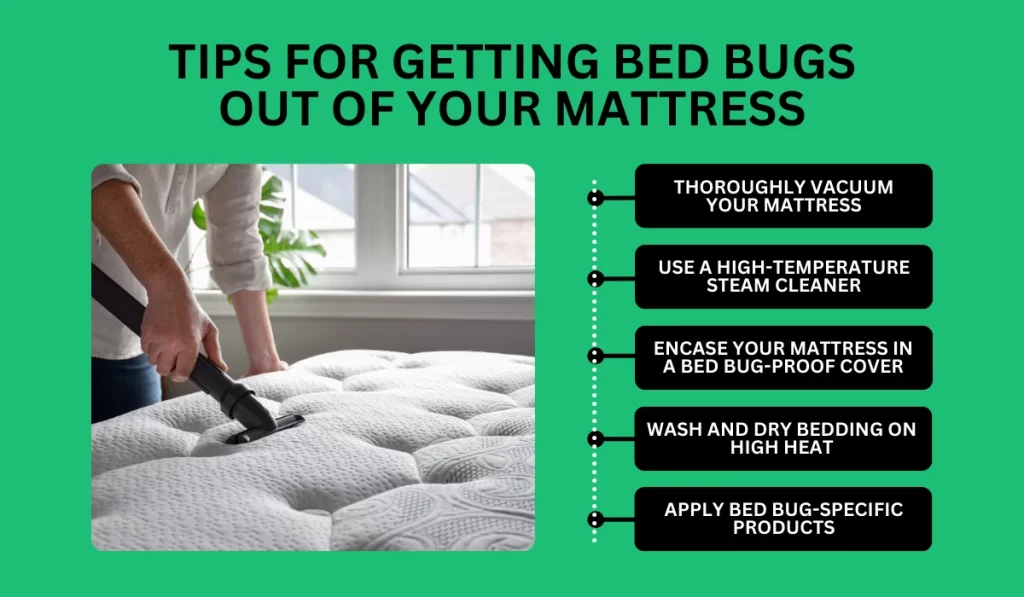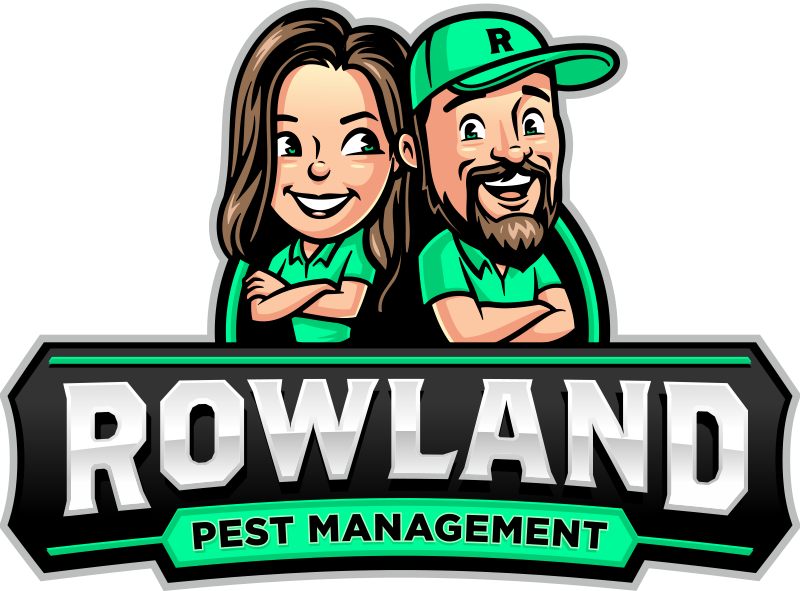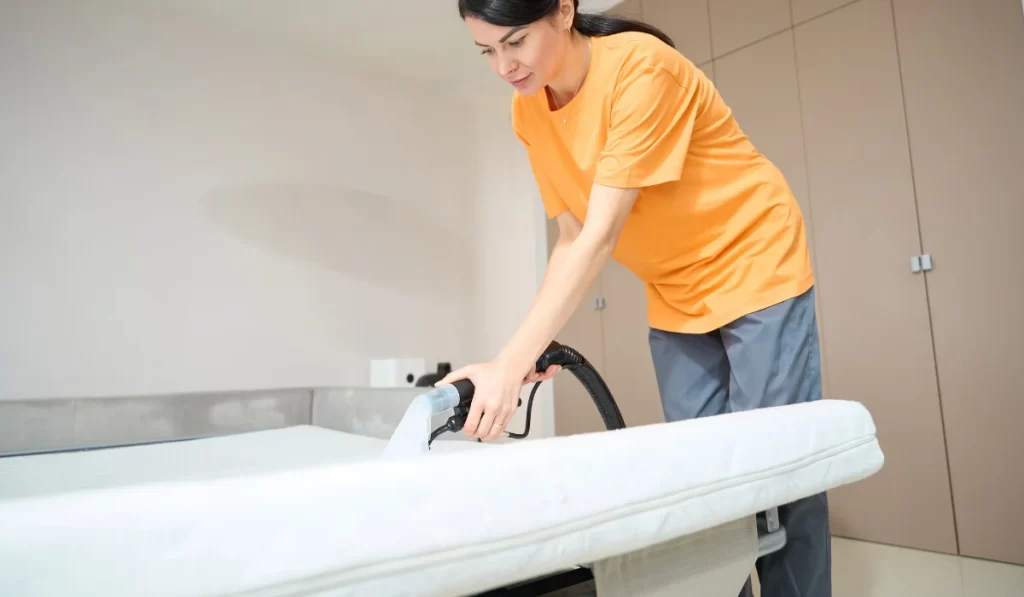Ever wonder if there’s a way to banish bed bugs from your mattress for good? These unwelcome guests can turn cozy nights into a biting nightmare. A direct approach is to vacuum the mattress thoroughly and use a mattress cover to trap bed bugs.
Staying bed bug-free is possible with the right tips and tricks, so keep reading to learn more.
Key Takeaways
- A thorough vacuuming of your mattress and bed frame helps remove bed bugs from hidden spots.
- High-temperature steam at 120°F kills bed bugs instantly without needing chemicals.
- A bed bug-proof mattress cover traps bugs inside and stops new ones from getting in.
- Washing and drying bedding on high heat effectively kills bed bugs and their eggs.
How to Remove Bed Bugs from Your Mattress

When dealing with a bed bug infestation in your mattress, a multi-step approach is the most effective way to ensure these persistent pests are removed.
Follow these five proven tips to protect your new mattress and home from bed bugs.
Thoroughly Vacuum Your Mattress
Vacuuming your mattress is a direct way to handle bed bugs. Start by using a powerful vacuum cleaner with a hose attachment. This allows for deep cleaning in seams and crevices where bed bugs hide.
Pay special attention to areas like the mattress seams and the edges. These are common hiding places for bed bugs. Use a crevice tool for tighter spots or areas. After vacuuming, immediately seal the vacuum bag in a plastic bag and discard it.
Repeat this process regularly to reduce the chance of infestation. Also, vacuum the bed frame, headboard, and baseboards for comprehensive treatment. A mattress protector can help keep bed bugs from returning.
Use a High-Temperature Steam Cleaner
Steam cleaning at high temperatures can kill bed bugs. A steam cleaner with a nozzle can penetrate the mattress, reaching into the depths where bed bugs might hide. Make sure that the steam is set to at least 160 degrees Fahrenheit.
Begin by running the steam cleaner over every inch of the mattress. Pay close attention to seams, folds, and any possible hiding spots. The high heat instantly kills bed bugs on contact, making this method effective and chemical-free.
If the infestation is heavy, a more systematic approach might be necessary, including treating nearby furniture such as couches and upholstered furniture.
Encase Your Mattress in a Bed Bug-Proof Cover
Mattress encasements act as a barrier against bed bugs. These encasements are designed to be bed bug-proof, preventing bugs from entering or exiting your mattress. This DIY method can be applied after vacuuming and steam cleaning.
Choose a tightly woven encasement that covers the entire mattress, including the box spring. The encasement traps existing bed bugs inside, cutting off their food source and eventually killing them. Similarly, it stops new bugs from getting in.
Wash and Dry Bedding on High Heat
Washing bedding such as sheets and pillowcases in hot water is another way to kill bed bugs. Combining water and high temperatures removes bed bug eggs and adults. Set the washing machine to the hottest setting.
Also, don’t forget items like linens, blankets, and other washable items near the infestation site. For foam or memory foam mattresses, avoid excessive heat treatment, which can cause the material to warp.
Apply Bed Bug-Specific Products
For targeted bed bug control, consider using products with pyrethroids. They include treatments in sprays, liquids, or powders. Follow carefully outlined instructions for these products to avoid harm to people and pets.
Spray the product around the bed frame, box spring, and other affected areas. Powders can be applied to cracks and crevices where liquid products can’t reach. Diatomaceous earth is a natural option when you’re avoiding harmful active ingredients.
How to Tell If Your Bed Bug Removal Methods Are Working
After getting rid of bed bugs, tracking the situation closely is essential. Here are key steps to help determine if your efforts are working and whether further action may be required.
Check the Mattress Regularly for New Signs of Bed Bugs
Regular inspections are crucial after implementing removal methods. Begin by looking for tiny, reddish-brown droppings or eggshells near mattress seams and tags. Sometimes, live bed bugs or nymphs may appear in those hiding spots.
Using a magnifying glass can aid in spotting smaller critters. Check electrical outlets and surrounding areas, too, as bed bugs often hide there. Bed bug bites can also suggest a lingering problem. They may appear as itchy welts in lines or clusters.
Track with Bed Bug Traps
Bed bug traps can be an effective way to measure the success of extermination efforts. For enhanced tracking, use several traps across the room. Some traps contain desiccant to catch and kill bugs.
Continued capture of adult bed bugs, especially over several days, suggests that more bed bugs may still be hiding in the environment, and more treatment is needed. When traps remain empty for weeks, it could signal a bed bug-free environment.
When to Call a Professional Pest Control Company for Bed Bugs
If you’ve tried the tips for getting your bed bug problem in your mattress but still see signs of an infestation, it’s time for pest control professional help.
At Rowland Pest Management, we offer expert solutions to get rid of these pests for good. While DIY methods like bug bombs or foggers help, our bed bug treatments provide thorough, lasting results to protect your home fully.
Don’t wait for the problem to worsen—contact us today for a free inspection and let our professional exterminators restore your comfort with trusted bed bug removal services.
Frequently Asked Questions
Can bed bugs spread from one room to another?
Yes, bed bugs can easily spread from one room to another by hitching a ride on clothing, furniture, or other belongings. They often move through wall voids or electrical outlets, making it crucial to address infestations promptly to prevent further spread.
How long does it take to get rid of a bed bug infestation?
The time to get rid of a bed bug infestation depends on the severity and the methods used. While smaller infestations may be resolved in weeks with consistent treatment, more severe infestations might need professional help and can take months to remove fully.


